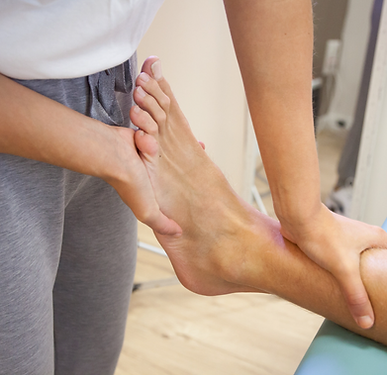top of page

LOWER LEG & ANKLE PAIN
Break free of pain and restore function
Lower leg and ankle pain can make walking, standing, or even resting uncomfortable and difficult. At Rehab Associates, our skilled therapists will work with you to reduce pain, improve mobility, and restore your ability to move freely again.
Next-day appointments without a referral
How can we help you?
-
How can physical therapy help me?Rehab Associates has helped hundreds of patients recover mobility, strength, and independence by addressing pain, improving physical function, and teaching daily living skills. Whether recovering from an injury, surgery, or managing a chronic condition, our expert therapists provide personalized care to support your journey toward better health and a higher quality of life.
-
What types of services do you offer?We offer a wide variety of outpatient physical therapy, occupational therapy, and wellness and fitness services, as well as several speciality programs tailored to your specific needs. Use the search feature or explore our website to find detailed information on specific conditions we treat and speciality programs.
-
Do you accept my insurance?We accept most insurance plans! For a complete list complete list, please visit our Insurance page.
-
How much is my copay?We would be happy to look into that for you! You can call us at (740) 345-2837 and have your insurance information available.
-
What is the self-pay rate?For patients without therapy insurance benefits, we offer self-pay options to make care accessible. Please call all our office at at (740) 345-2837 for current pricing.
-
What are your hours? Can I come after work during the evening?Our hours for each office are as follows: Health/Newark Office Monday and Wednesday: 7 am - 7 pm Tuesday and Thursday: 8 am - 7 pm Friday: 8 am - 5 pm Dresden Office Monday and Tuesday: 8 am - 5 pm Wednesday and Friday: 8 am - 4 pm Thursday: 8 am - 6:30 pm
-
What should I bring on the first day?Please bring your 𝐢𝐧𝐬𝐮𝐫𝐚𝐧𝐜𝐞 𝐜𝐚𝐫𝐝 and 𝐩𝐡𝐨𝐭𝐨 𝐈𝐃. If you were able to fill out your patient intake paperwork, please bring that as well. If not, please arrive 15 minutes early so that you have enough time for a thorough evaluation. Visit our What to Expect page for more information.
-
Do I need my insurance card?Yes! Please bring your insurance card and photo ID to your appointment.
-
Has my script arrived? Has my referral come through?Our office staff will reach out to you as soon as your referral has arrived. We look forward to getting you scheduled! You can call us at (740) 345-2837.
-
Who is my therapist?We would be happy to look into that for you! You can call us at (740) 345-2837.

bottom of page
